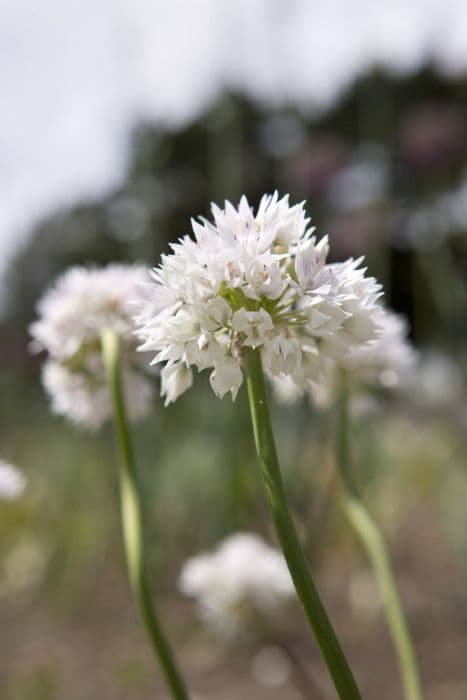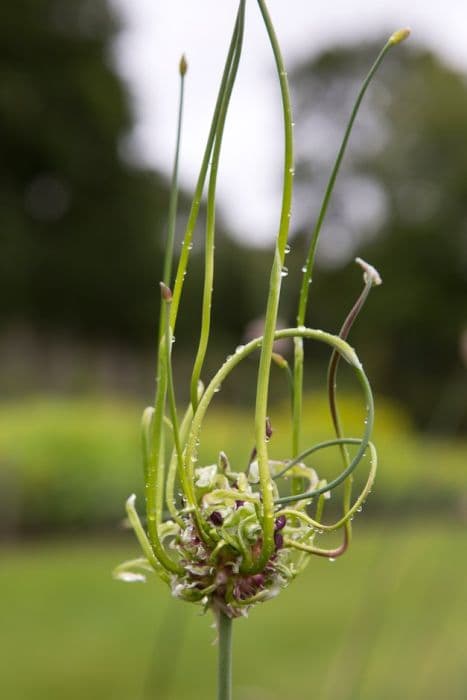Giant Allium Allium giganteum

ABOUT
The giant onion is a striking and architecturally bold plant that is easily recognizable for its large and spherical flower heads. These flower heads are made up of numerous small, star-shaped blooms that are typically a vibrant shade of purple, although they can sometimes be found in shades of pink or white. This dense cluster of flowers emerges on a sturdy, upright stalk that rises above the foliage. The leaves of the giant onion are long, slender, and glossy, creating an elegant, grass-like appearance at the base of the plant. They have a deep green color and are arranged in a basal rosette, gracefully arching outward from the center. This foliage provides a lush background for the showy, spherical umbels that crown the plant at the peak of its blooming season. The sheer size and structure of the flower heads make the giant onion a focal point in any garden setting. Their globular form gives rise to other common names such as 'ornamental onion,' suggesting their aesthetic appeal and membership in the onion family. Despite its name, the giant onion is admired for its ornamental qualities rather than any culinary use. Overall, the giant onion has a majestic and robust presence, with its combination of striking flower clusters and attractive greenery contributing to its popularity among gardeners and landscape designers looking for a plant with visual impact. Its durability and unique form make it a distinctive choice for beds, borders, and as an accent plant.
About this plant
 Names
NamesSynonyms
Giant Onion, Ornamental Onion, Persian Onion
Common names
Allium giganteum.
 Toxicity
ToxicityTo humans
The plant known as giant onion is not considered highly toxic to humans. However, as with many plants, it can potentially cause mild stomach upset if ingested in large quantities. People with a sensitivity or allergy to Allium species may experience more pronounced symptoms such as nausea, vomiting, or diarrhea if they consume parts of the giant onion. Despite its potential for causing mild gastrointestinal distress, it is not known to cause severe poisoning or life-threatening effects in humans.
To pets
The giant onion is toxic to pets, particularly cats and dogs. It belongs to the Allium family, which also includes onions, garlic, leeks, and chives, all of which are known to be poisonous to cats and dogs. The ingestion of giant onion can lead to symptoms such as gastrointestinal upset, drooling, nausea, oral irritation, and abdominal pain. In more severe cases, it can cause hemolytic anemia, which is the destruction of red blood cells, leading to symptoms like lethargy, pale gums, rapid breathing, and ataxia. If a pet consumes a large amount of giant onion or if symptoms are observed, it is important to seek veterinary care promptly.
 Characteristics
CharacteristicsLife cycle
Perennials
Foliage type
Deciduous
Color of leaves
Green
Flower color
Purple
Height
3-4 feet (0.91-1.22 meters)
Spread
1-2 feet (0.30-0.61 meters)
Plant type
Bulb
Hardiness zones
5
Native area
Central Asia
Benefits
 General Benefits
General Benefits- Ornamental Value: Allium giganteum, commonly known as Giant Allium, is prized for its striking spherical flowers that add aesthetic appeal to gardens and landscapes.
- Attracts Pollinators: Its blooms attract bees, butterflies, and other beneficial insects, supporting local biodiversity.
- Drought Tolerance: Once established, it is tolerant to drought, making it suitable for water-wise gardens.
- Deer and Rodent Resistance: The plant's strong onion scent is a natural deterrent to deer and rodents, protecting it from grazing.
- Low Maintenance: Giant Allium requires minimal care once planted, making it a convenient choice for gardeners of all skill levels.
- Culinary Use: Some parts of the plant are edible and are used in culinary applications for their onion-like flavor.
- Long Bloom Time: The flowers of the Giant Allium bloom in late spring to early summer, providing long-lasting visual interest in the garden.
- Easy to Propagate: It can be easily propagated through division, making it simple to spread throughout the garden or share with others.
 Medical Properties
Medical PropertiesThis plant is not used for medical purposes.
 Air-purifying Qualities
Air-purifying QualitiesThis plant is not specifically known for air purifying qualities.
 Other Uses
Other Uses- Gigantic Onion can be used as a natural fencing or barrier due to its size and dense foliage, providing privacy in gardens and landscaped areas.
- The plant can function as a natural pest deterrent owing to its strong scent, which can repel certain insects and critters from gardens.
- It can be used as a dye plant; the leaves, when crushed, can produce a green dye for fabrics and crafts.
- Gigantic Onion, with its striking appearance, is often utilized in photography for plant and garden-themed shoots.
- The dried seed heads can be used in floral arrangements or as a part of decorative wreaths to add an architectural element.
- Due to its large structure, it can serve as a natural support for smaller, climbing plants in mixed borders.
- The plant can also be used in educational settings as an example of bulbous plant growth and lifecycle studies.
- Artists and illustrators may use Gigantic Onion as a subject for botanical drawings and watercolor paintings, capturing its unique structure.
- It can be used to create contrasting texture in tactile gardens designed for sensory experiences.
- Gigantic Onion is suitable for creating themed gardens, such as "giant" or "fantasy" gardens due to its towering flowers.
Interesting Facts
 Feng Shui
Feng ShuiThe Giant Allium is not used in Feng Shui practice.
 Zodiac Sign Compitability
Zodiac Sign CompitabilityThe Giant Allium is not used in astrology practice.
 Plant Symbolism
Plant Symbolism- Unity and Humility: Allium giganteum, commonly known as Giant Allium, carries a meaning of unity due to its spherical cluster of small flowers that symbolize the many separate parts coming together to create a harmonious whole.
- Strength and Patience: The tall and robust nature of the Giant Allium stands as a symbol for inner strength and the patience required for personal growth, reflecting its own gradual and steadfast development.
- Prosperity and Abundance: As a member of the onion family, Allium giganteum is also associated with prosperity and abundance, echoing the themes of bountiful harvests and the lush fullness of its flower heads.
- Good Fortune and Luck: In some cultures, the Giant Allium is considered to bring good luck and is planted with the belief that it wards off evil spirits, symbolizing protection and the attraction of positive energy.
 Water
WaterGiant Alliums require moderate watering, especially during the spring and early summer when they are actively growing. They should be watered deeply, with about half a gallon per plant, once a week if there has been no significant rainfall. The soil should be allowed to dry out slightly between waterings, as these plants do not like to be in waterlogged soil. During dormant periods in late summer and fall, reduce watering to prevent rot.
 Light
LightFor optimal growth, the Giant Allium needs full sun exposure for at least 6 hours a day. The best spot for a Giant Allium is in an area where it will receive plenty of direct sunlight, which is essential for the development of the large, spherical blooms.
 Temperature
TemperatureThe Giant Allium thrives in a temperate range, with ideal growing temperatures between 55°F and 75°F. They can survive brief periods of colder weather, down to about 20°F, and hotter conditions, up to 90°F, but prolonged exposure outside of their ideal range can be detrimental to their health.
 Pruning
PruningPruning of the Giant Allium involves deadheading the spent flower heads to encourage new growth and prevent self-seeding. It is best done right after the flowers fade in late summer. Pruning is not often required for foliage, as the leaves will naturally die back after blooming. However, you should remove any damaged or diseased foliage as needed.
 Cleaning
CleaningNot needed
 Soil
SoilGiant Allium thrives in well-draining soil with a pH range of 6.0-8.0. A mix containing equal parts of garden soil, peat moss, and perlite or sand is ideal to ensure proper drainage and aeration.
 Repotting
RepottingGiant Alliums generally do not need frequent repotting; it is typically done every 3-4 years or when the bulbs outgrow the container.
 Humidity & Misting
Humidity & MistingGiant Allium prefers average air humidity levels and does not require special humidity conditions to grow well.
 Suitable locations
Suitable locationsIndoor
Ensure bright light and well-draining soil.
Outdoor
Plant in full sun and well-drained soil.
Hardiness zone
4-9 USDA
 Life cycle
Life cycleAllium giganteum, commonly known as Giant Allium, begins its life cycle with seed germination, usually in late summer or autumn, where the seeds require well-drained soil. After germination, a bulb forms underground, and over the winter, this bulb enters a period of dormancy. With the arrival of spring, new shoots emerge from the bulb, followed by long, sturdy stems and strap-shaped leaves. By late spring to early summer, the plant reaches the flowering stage, displaying large, globe-shaped, purple flower clusters that are attractive to pollinators. After the flowering stage, seeds develop and are dispersed as the flower heads dry out. The plant then goes dormant during the summer, with the cycle beginning anew if conditions are favorable for the seeds or bulbils produced to germinate.
 Propogation
PropogationPropogation time
Spring to early summer
The most popular method of propagation for Allium giganteum, commonly known as Giant Allium, is by seed. To successfully propagate Giant Allium by seed, the process should ideally begin in the fall. Seeds should be sown in a well-draining soil mix, barely covering them with soil. The container should be placed in a cold frame or outdoors to expose it to winter temperatures; this stratification process aids in breaking seed dormancy. In spring, as the temperatures rise, the seeds will germinate. Seedlings can then be moved to individual pots and grown on until they are large enough to be planted out in the garden, after the risk of frost has passed. This process of growing from seed can take a few years before the plant reaches flowering size.








